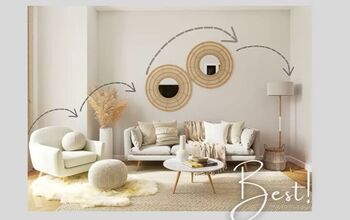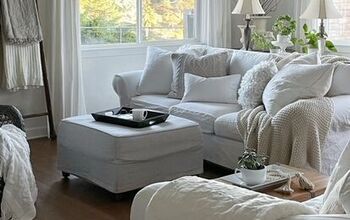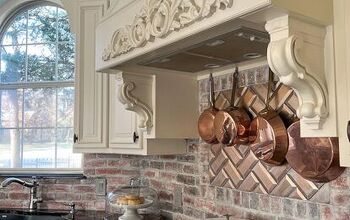Top 10 Interior Design Mistakes and How to Fix Them: Expert Tips

Let there be light! Lighting makes such a crucial difference in our homes, but it can be a balance to get right. Making the most of natural light, having enough light in a room for practical reasons, as well as the option of dimmer, cozier lights for evenings, so that we fall asleep better.
Interior designer Rebecca Robson recently shared valuable insights in her latest video as part of her ongoing series about common home design mistakes (see her previous episode on window treatment mistakes here).
This episode focused on the critical role of lighting in creating a warm, inviting, and functional home environment. According to Rebecca, many people underestimate the impact of lighting, often defaulting to the typical arrangement of canned lights—three in a row on the ceiling—which she argues is a missed opportunity for more thoughtful and effective lighting design.
Here's the video with the main points summarized below:
Table of contents
- 1. Inadequate Lighting
- 2. Neglecting Maintenance
- 3. Mismatch of Bulb Colors
- 4. Incorrect Placement of Can Lights
- 5. Overlooking the Importance of Dimmers
- 6. Ignoring the Power of Floor and Table Lamps
- 7. Hanging Chandeliers Too High or Without Purpose
- 8. Improper Placement of Ceiling Lights
- 9. Random Placement of Sconces
- 10. Forgetting About Symmetry
1. Inadequate Lighting
Lighting is a critical element in home design, yet many people underestimate its impact. Rebecca points out that homeowners often settle for basic lighting setups, such as installing canned lights in a simple grid pattern without considering the purpose of the lighting.
The solution? Layer your lighting with ambient, task, and accent lights. Use dimmable lights to create different moods and ensure all light bulbs in a room match in color temperature for a cohesive look.
2. Neglecting Maintenance
Over time, light fixtures accumulate dust and grime, which can diminish their brightness and overall appearance. Rebecca emphasizes the importance of regularly cleaning light fixtures, especially chandeliers, and other statement pieces.
A clean light fixture can drastically improve the brightness of a room and enhance its overall aesthetic.
3. Mismatch of Bulb Colors
A common mistake Rebecca sees is the use of different colored light bulbs in the same space. This can create an inconsistent and disjointed look.
Her recommendation is simple: ensure all light bulbs in a room are of the same color temperature, whether warm or cool, to maintain a harmonious atmosphere.
4. Incorrect Placement of Can Lights
Many homeowners rely solely on canned lights for their ceiling lighting, often placing them in straight lines without considering what they are meant to illuminate.
Rebecca suggests placing can lights strategically to highlight specific areas or features in a room, such as artwork, architectural details, or seating areas. This method not only enhances the functionality of the lighting but also adds depth and interest to the space.
5. Overlooking the Importance of Dimmers
Rebecca cannot stress enough the importance of installing dimmers on your lights. Dimmers allow you to control the intensity of your lighting, making it easy to set the right mood for any occasion. If your canned lights are not dimmable, consider replacing them with dimmable versions for greater flexibility.
6. Ignoring the Power of Floor and Table Lamps
Rebecca points out that many people don’t realize the importance of floor and table lamps in creating a balanced and inviting space. Often, lamps are mismatched in style or scale, which can disrupt the flow of a room.
Rebecca recommends choosing lamps that complement each other and the room’s overall design. Pairing similar lamps on either side of a sofa or bed can create symmetry and enhance the room's visual appeal.
7. Hanging Chandeliers Too High or Without Purpose
One common error Rebecca highlights is hanging chandeliers too high or placing them in a space where they have no clear purpose.
Chandeliers should be positioned low enough to relate to the furniture beneath them, creating a sense of intimacy and purpose. If a chandelier is placed in the middle of a room with no furniture underneath, it can appear awkward and out of place.
8. Improper Placement of Ceiling Lights
Similar to the issue with canned lights, ceiling lights like chandeliers or pendants often get placed in the wrong spot, leading to poor lighting distribution.
Rebecca advises ensuring that ceiling lights are centered over furniture, like a dining table or seating area, to create a balanced and functional space. If a ceiling light is off-center, it can throw off the entire room's look.
9. Random Placement of Sconces
Wall sconces are a fantastic way to add ambient lighting and architectural interest to a room. However, when placed too high or without consideration for what they are meant to illuminate, they can look awkward.
Rebecca suggests positioning sconces at an appropriate height (generally eye level) and using them to highlight artwork, mirrors, or architectural features.
10. Forgetting About Symmetry
Symmetry is a powerful tool in design that creates a sense of order and balance. Rebecca often sees homes where furniture, lighting, and decor items are randomly placed without regard for symmetry, leading to a chaotic or unfinished look.
She recommends paying attention to the placement of items in a room, ensuring that there is a sense of balance, whether it’s through the use of pairs of lamps, matching side tables, or evenly spaced wall decor.
Conclusion
Rebecca Robson’s expert advice highlights the importance of thoughtful design and attention to detail in creating a cohesive and visually appealing home.
Whether it’s by adjusting the placement of lighting, cleaning fixtures, or introducing symmetry, small changes can make a big difference in the overall feel and functionality of a home.
Did any of these mistakes surprise you? Let us know in the comments below.





















Comments
Join the conversation